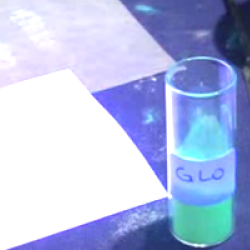Source Institutions
Source Institutions
Add to list Go to activity
Activity link broken? See if it's at the internet archive

In this activity, learners explore phosphorescence and how certain materials can absorb and store energy from a light source. Learners use critical thinking skills to hypothesize which type of light -- incandescent, ultraviolet, infrared or fluorescent -- will produce the brightest glow from a glow-in-the-dark star. Learners perform an experiment using cameras to observe the intensity of the resulting glow from each type of light source.
- Under 5 minutes
- 45 to 60 minutes
- $10 - $20 per group of students
- Ages 11 - 14
- Activity, Experiment/Lab Activity, Lesson/Lesson Plan
- English
Quick Guide
Materials List (per group of students)
- One lamp fixture
- One incandescent light bulb - 40 watts
- One compact fluorescent light bulb - 7 watts
- One ultraviolet light or black light bulb - 40 watts
- One infrared or red heat bulb - 40 watts
- Glow-in-the-dark stars, all in the same size
- One camera
Subjects
-
Engineering and Technology
- Engineering
- Technology
-
Physical Sciences
- Energy
- Vibration and Waves
-
Light and Optics
- Electromagnetic Spectrum
-
The Nature of Science
-
The Scientific Process
- Conducting Investigations
- Formulating Explanations
- Communicating Results
-
The Scientific Process
-
The Nature of Technology
-
Technology and Society
- Impacts of Technology
- Technology and the Environment
-
Technology and Society
Informal Categories
- Photography and Film/Video
- Toys
Audience
To use this activity, learners need to:
- see
- see color
Learning styles supported:
- Involves hands-on or lab activities
Other
Includes alignment to state and/or national standards:
This resource is part of:
Access Rights:
- Free access
By:
- Education, Science Friday
Rights:
- All rights reserved, Science Friday, 2011
